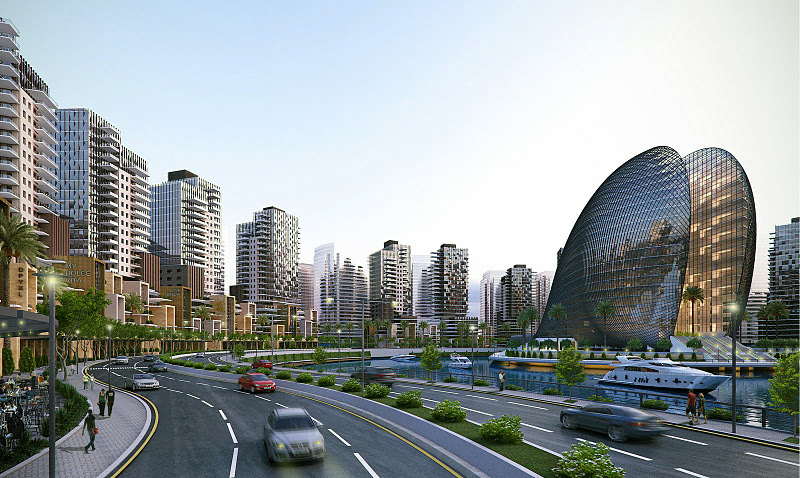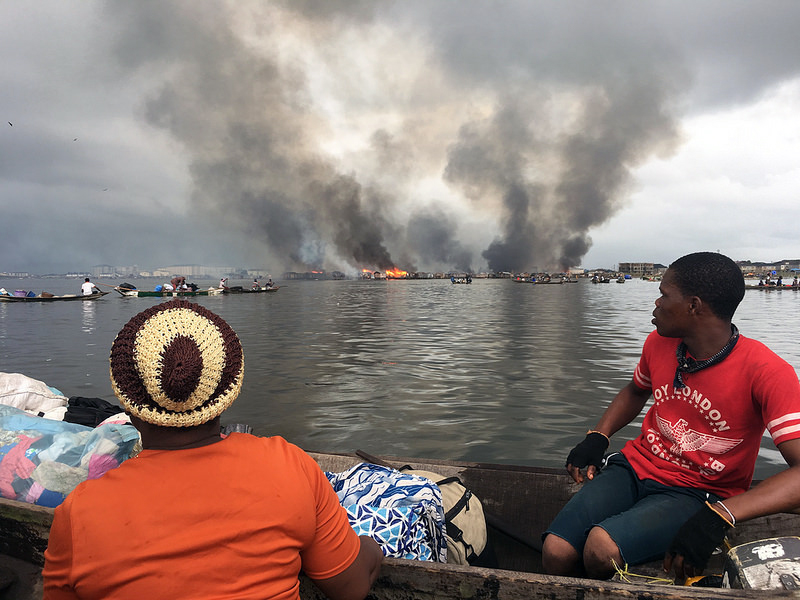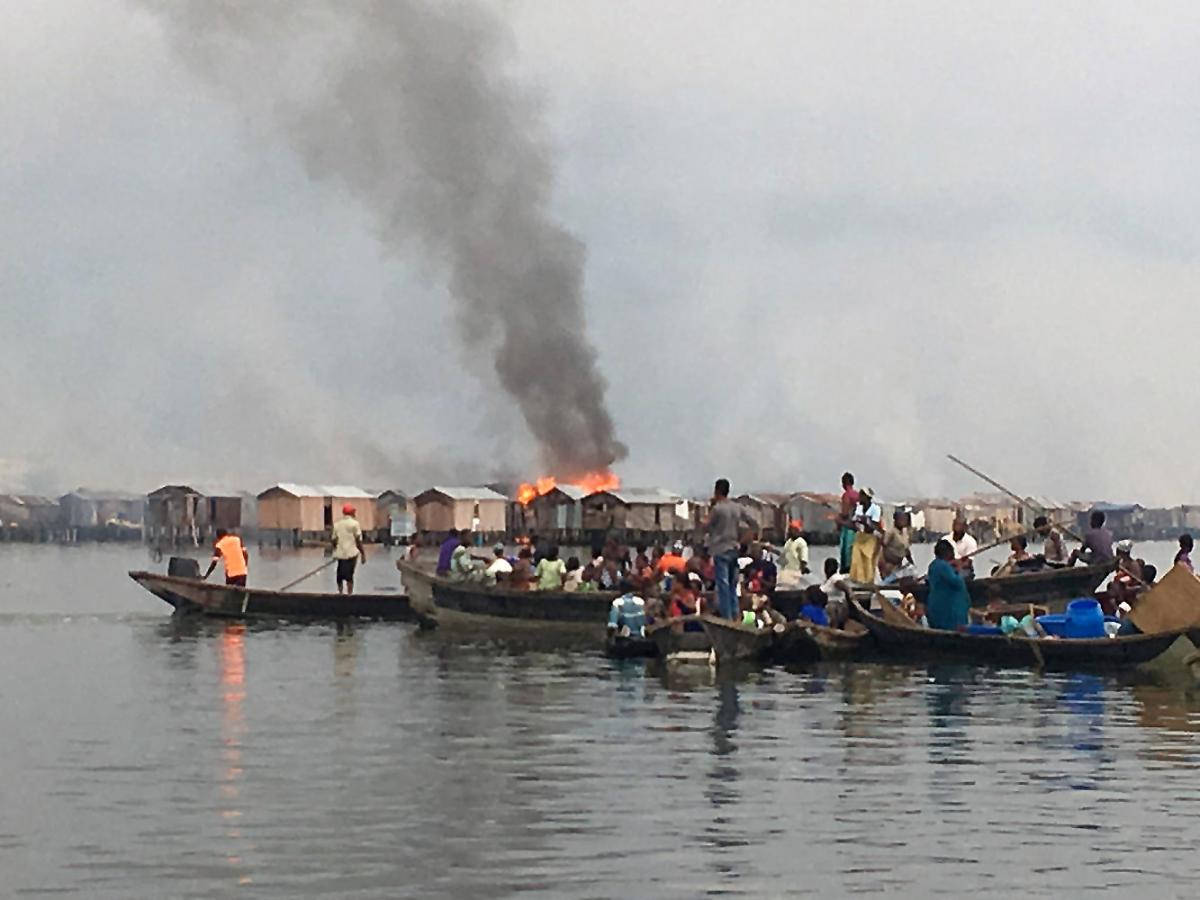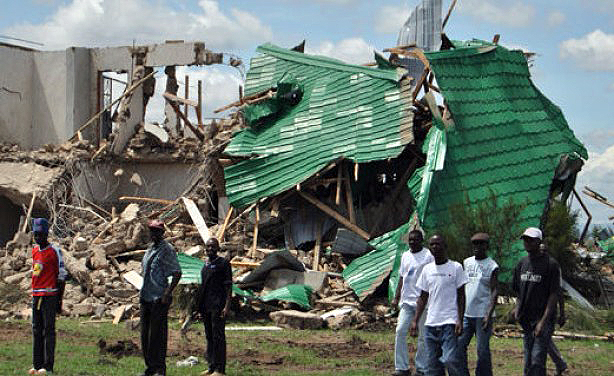
THIS ARTICLE IS REPRINTED IN ITS ENTIRETY THROUGH THE COURTESY OF COMMON EDGE, A NONPROFIT ORGANIZATION DEDICATED TO RECONNECTING ARCHITECTURE AND DESIGN WITH THE PUBLIC THAT IT IS MEANT TO SERVE. READ THE ORIGINAL ARTICLE HERE. Image above: a rendering of Eko Atlantic City, Lagos, Nigeria, from ekoatlantic.com.
In the last two decades, the African narrative has changed phenomenally. The tired, age-old storyline—largely woven around the stereotypes of poverty, disease, and bloody civil wars—has been replaced with one celebrating the continent’s unprecedented economic growth and relative political stability. This new narrative is also about Africa’s gleaming skyscrapers, massive shopping malls, and ambitious “smart” cities being designed and built from scratch: Ebene Cyber City in Mauritius; Konza Technology City in Kenya; Safari City in Tanzania; Le Cite du Fleuve in DR Congo; Eko Atlantic in Nigeria; Appolonia City in Ghana, and others.
There are currently at least 20 of these new cities under construction in Africa and about twice that number in the works. These developments have permanently altered the continent’s urban outlook and have offered it something different from the bland pastiche of colonial architecture that it was once known for. As a designer, I was initially excited by the quality of some of the architecture. Though I must admit that these new cities are eerie mimicries of similar developments in China, Singapore, and even the U.A.E. and that they’re largely bereft of any cultural connection to Africa.
Tragically, this new narrative depicts just a small piece of a much bigger and more disturbing picture. These developments are available to a small segment of Africa’s vast population. As a result, the euphoria that greeted the birthing of these new cities is gradually being replaced with anger and fear. Most Africans have become disenchanted by the high social cost of these urban makeovers. They’re now seen as the prize or spoils of war, from the ongoing battle between those at the top of the social pyramid and those struggling at the bottom.
The living conditions in these upscale neighbourhoods are starkly different from those found in low-income communities, which all too often lack basic infrastructure: roads, a public water supply, even efficient waste management systems. This uneven distribution of public amenities has become distressingly typical of most African cities. And, as if that weren’t bad enough, many poor communities are now being ruthlessly annexed and its residents pushed out, to make way for these new developments.

A few weeks ago, the residents of Otodo-Gbame, a fishing settlement in Lagos, awoke at dawn to the sounds of gunfire and the sight of more than 60 policemen, accompanied by bulldozers and a demolition task force, sent in by the Lagos State Govern-
ment (LASG). The group proceeded to pull down all of the houses standing on land, while those erected on stilts in the water were set ablaze, forcing terrified residents to scurry out of their homes to safety through a thick haze of smoke and tear gas, and a hail of bullets. Residents then watched helplessly from afar as thick smoke billowed over the remains of what they once called home.
According to Justice & Empowerment Initiatives, a group that advocates on behalf of endangered waterfront communities in Lagos, the forced evacuation resulted in the death of one resident from gunshot wounds to the neck; several others were shot; about 4700 people lost their homes and personal belongings. The demolition—Amnesty International called it “a brazen land grab”—was the ugly climax to long-simmering land disputes between the LASG and the Otodo-Gbame community, who claim to have lived on those lands for close to a century. Although the residents obtained an injunction from a Lagos High Court restraining the LASG from demolishing their settlement pending the final determination of a lawsuit, the government went ahead and destroyed it in absolute disregard of the court.

brutal, settlement-clearing demolitions taking place across
Africa on a daily basis." Photo courtesy of Justice & Empow-
erment Initiatives via Common Edge.
Otodo-Gbame has become a lightning rod, a symbol for the brutal, settlement-clearing demolitions taking place across Africa on a daily basis. Most residents of low-income communities in Nigeria live in constant fear of eviction. Mpape, a poor neighbourhood in Abuja, borders two of the capital city’s more affluent neighbourhoods. It is an extremely dense area, with an estimated population of at least 500,000 (although residents insist the correct figure is at least twice this number, given the daily influx of uncounted people into the settlement).
I first visited Mpape in 2005 as an architecture student intern. I had been asked by my supervisor to accompany a land surveyor and sketch out a proposed site for a telecommunication mast and base station. Even then, the living conditions in Mpape were grim; with the steady influx of still more people into the district in the last decade, they have deteriorated even more since. The sole access into this huge settlement is a narrow two-lane road riddled with potholes. Dense and vibrant, the settlement is very much ad hoc urbanism. The houses typically stand swearing at one another on all sides of the dusty, narrow streets, which are often bordered by open, shallow earthen drains. There are no clear delineations of activity. People simply build whatever they want, however they want, wherever they find land.
Because of its proximity to the city centre, Mpape occupies prime real estate. The slum has also become a crucial source of affordable housing for Abuja’s large army of blue-collar workers, low-cadre civil servants, taxi drivers, and artisans. Today, a court injunction is all that stands between the settlement and the Federal Capital Development Authority (FCDA)’s bulldozers. The residents of Mpape instituted a lawsuit in 2012 to stop the demolition and since then have been locked in a legal battle. The FCDA, for its part, insists that the residents are squatters; they have neither legal title to the land nor building permits for the houses they constructed. Eventually, they plan to proceed with the demolition of the settlement.
Despite the legitimacy of FCDA’s legal claims—the residents are squatters—the forced demolition of Mpape, without either compensation or a smart resettlement plan, would be socially catastrophic. It has the potential to set off a chain reaction of destabilizing events. Imagine displacing, in one grand and ugly swoop, the entire populations of cities the size of Kansas City, Omaha, Minneapolis, New Orleans, or even Miami. Given the sheer number of people and families involved, the likelihood of social fragmentation, economic upheaval, and unrest would be extremely high.
And where, ultimately, does this policy lead? Displaced residents will simply set up new slums elsewhere in the same cities, if only for a brief moment before they are sent packing again. They will be unable to afford the new homes being built on the land where their old homes once stood. This insane cycle of demolition and development has resulted in large swaths of empty, upscale real estate scattered all over Abuja. Many houses have never been occupied, because the owners can’t find tenants for them. Of course, there is no shortage of people to live in these new homes, just a dearth of people who can afford them.

of Nigeria, might seem like a straightforward solution, but they "are a
direct byproduct of official neglect, which is what has fueled their
emergence and subsequent growth in the first place." Image by Anthony
Omuya/DailyNation via AllAfrica.
Winning in court will not absolve city authorities of their responsibilities to the people in settlements such as Mpape. These communities have become vital parts of our city’s social fabric.
They work, pay taxes, and contribute in their own way to the growth of our local economy. They simply can’t be dismissed by the wave of the hand. Besides: these slums are a direct byproduct of official neglect, which is what has fueled their emergence and subsequent growth in the first place.
Sadly, I believe that these demolitions will continue, because Africa’s new urban ideology is built on the singular premise of keeping out of sight the poor, the unsightly, and everything that reminds it of its difficult past. We seem to be in a haste to erase all of the unpalatable epithets to which it was forced to answer for several decades. As a result, we’re deploying massive resources to fund a ephemeral urban vision, regardless of the cost. This approach is not only corrupt and disingenuous but does little to promote peace and good neighbourliness (an attribute Africans are known for). And because it deploys too many communal resources for the advancement of a select few, it negates the first principle of social equity. Ultimately, this strategy attacks the symptoms of Africa’s dysfunctional cities by short-circuiting its natural growth process, while failing to acknowledge the underlying factors that created them.
Every new city we design and build must be a patchwork of compromise and sacrifice from both sides of the social divide. We must learn to build our cities around our people, rather than structures. Cities should be vehicles for social integration, not tools for division. It’s in this light that I would beseech fellow designers and architects and the entire AEC industry globally: in spite of the allure of working in Africa, designers must be wary of the sordid backstories behind some of these ambitious urban projects, as well as the moral liabilities that comes with them. If the global design community stayed away from these kinds of blood-tainted briefs, it would not only send out the desired message to city authorities across Africa but would also compel them to act more humanely in dealing with victims of forced demolitions.
Atrocities committed against communities like Otodo-Gbame can never be fully erased by the gleaming waterfront villas, promenades, and marinas that will soon rise from the ashes of the demolished slum. It doesn’t matter what new names the communities will be christened with tomorrow; its erstwhile residents will always look across the beautiful “new” skyline, searching for the place where their homes once stood. 

